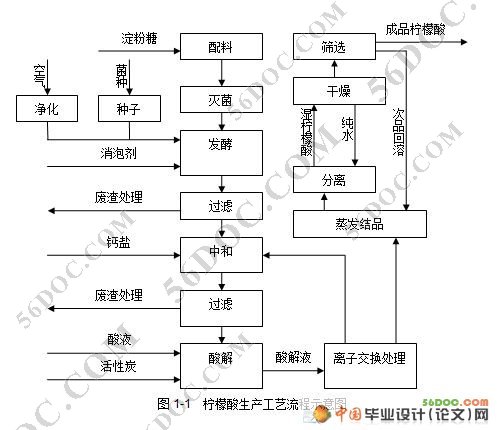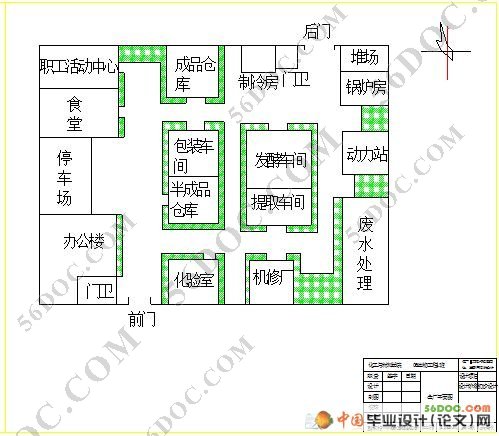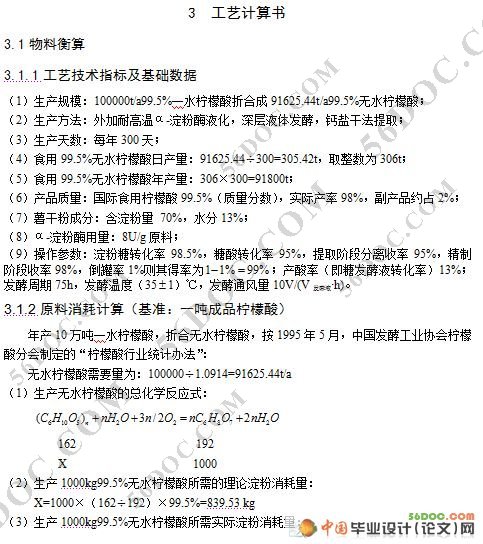摘 要
本设计采用薯干原料发酵,只需将薯干磨成粉,加水调浆,直接加入少量α-淀粉酶液化后灭菌、冷却即可接种发酵。制备柠檬酸一般采用晒干的薯干作为原料。其中薯干含水10%-15%、淀粉70%左右、蛋白质6%左右。薯干原料中的蛋白质可作为氮源供菌体生长。薯干原料中含有铁、镁、钾、钙等的无机盐,选用的黑曲霉C0527对这些成分不敏感,故不必对原料做这方面的预处理。本设计采用液体深层好氧发酵、钙盐法提取技术生产柠檬酸。这两种方法都是国内比较流行的生产方法,有着大量的实际经验,易于操作,风险小。
由于本设计为糖化、发酵车间的设计,着重于这两个车间的工艺计算、设备选型。通过全厂物料衡算、车间热量衡算,确定糖化、发酵车间主要设备发酵罐、种子罐、车间管道的设计和选型以及全厂及车间布置。
本设计还包括发酵罐,全厂平面图,车间平面布置图,工艺流程图。
关键词:薯干 深层好氧发酵 黑曲霉 柠檬酸 设备设计和选型
Annual output of 100,000 tons citric acid plant saccharification fermentation,fermentation plant design
ABSTRACT
The design of raw materials used potato fermentation, simply potato mills, water-paste, adding a small amount of direct α-amylase liquefaction, sterilization, cooling, fermentation can be vaccinated. Preparation of citric acid normally used as raw materials dried potato. Potato moisture content of 10% to 15%, about 70 percent of starch, protein about 6 percent. Potato raw materials in the protein can be used as source of nitrogen for cell growth. Potato raw materials containing iron, magnesium, potassium, calcium of inorganic salt, optional black Aspergillus niger C0527 is not sensitive to these ingredients, it need not do any pretreatment of the raw materials. The design of a good gas liquids deep fermentation, dry calcium citrate extraction technology production. The two methods are more popular domestic production methods, has a great deal of practical experience, easy to operate, the risk small. As the design for the saccharification and fermentation workshop the design, the two workshops focused on the process, the selection of equipment. Through the whole plant material balance, energy balance workshop, identified glycosylation, fermentation workshop major equipment fermenter, seed tanks, pipelines and workshops in the design and selection. And the whole plant and facility layout.
The design also includes Fermentor, The factory plan, Shop floor plan, Flow Chart.
Key words: Potato Deep-seated aerobic fermentation Aspergillus niger Citric acid Equipment Design and Selection
本次生产工艺的基本过程是:
在接收糖浆后,根据糖浆组成作适当的处理或配制,配成发酵原料,进行连续杀菌并冷却后,进入发酵罐,加入菌种和净化压缩空气后进行发酵;
发酵液经升温、过滤处理后,进入中和罐,用CaCO3中和处理;
再经过过滤洗涤,得到柠檬酸钙固体,送入酸解罐,再添加H2SO4酸解,并加入活性炭进行脱色;
然后,通过带式过滤机过滤、酸解过滤,除去CaSO4及废炭;
酸解过滤液经离子交换处理后,进行蒸发、浓缩,再进行结晶;
结晶后,用离心机进行固液分离,对得到的湿柠檬酸晶体进行干燥与筛选,最后得到成品的柠檬酸。



目 录 14000字
摘要……………………………………………………………………Ⅰ
ABSTRACT…………………………………………………………...Ⅱ
1.引言……………………………………………………………...........1
1.1柠檬酸的性质和用途……………………………………………………..1
1.2柠檬酸的来源和发展情况………………………………………………..1
2.生产工艺…………………………………………………………………..2
2.1生产方法…………………………………………………………………..2
2.2生产流程…………………………………………………………………..2
2.3操作工艺…………………………………………………………………..3
2.3.1原料的处理……………………………………………………………...3
2.3.2发酵工序...............................……………………………………………3
2.3.3醪液处理工序…………………………………………………………...3
2.3.4提取工段………………………………………………………………...3
2.3.5精制工段………………………………………………………………...4
3.工艺计算书………………………………………………………………..5
3.1物料衡算…………………………………………………………………..5
3.1.1工艺技术指标及基础数据……………………………………………...5
3.1.2原料消耗计算(基准:1吨成品柠檬酸)………………………………5
3.1.3发酵醪量的计算………………………………………………………...6
3.1.4接种量…………………………………………………………………...6
3.1.5液化醪量的计算………………………………………………………..6
3.1.6成品柠檬酸……………………………………………………………...6
3.1.7淀粉质原料年产10万吨一水柠檬酸厂总物料衡算………………….7
3.2热量衡算…………………………………………………………………..7
3.2.1液化热平衡计算………………………………………………………...7
3.2.2发酵过程中的蒸汽耗量的计算………………………………………...8
3.2.3发酵过程中的冷却水耗量计算……………………………………….10
3.2.4发酵过程中的无菌空气耗用量的计算……………………………….10
4.糖化车间设备设计与选型…………………………………………......12
4.1调浆桶的选型……………………………………………………………12
4.2喷射加热器的选型………………………………………………………12
4.3液化维持罐的选型………………………………………………………13
4.4板式换热器的选型………………………………………………………13
5.发酵车间设备设计与选型…………………………………………......15
5.1发酵罐的选型…………………………………………………………....15
5.1.1发酵罐容积和台数的确定……………………………………………15
5.1.2主要尺寸的计算………………………………………………………16
5.1.3发酵罐冷却面积的计算………………………………………………16
5.1.4发酵罐搅拌器的设计…………………………………………………17
5.1.5发酵罐设备结构的工艺设计…………………………………………18
5.1.6发酵罐设备材料的选择………………………………………………20
5.1.7发酵罐壁厚的计算……………………………………………………20
5.1.8发酵罐接管设计……………………………….....................................21
5.1.9发酵罐支座的选择…………………………………………………….22
5.2种子罐的选型……………………………………………………………22
5.2.1种子罐容积和数量的确定……………………………………………22
5.2.2种子罐主要尺寸确定…………………………………………………22
5.2.3种子罐型号确定………………………………………………………23
5.3贮罐选型…………………………………………………………………23
5.3.1发酵成熟醪贮罐……………………………………………………….23
5.3.2硫酸銨贮罐…………………………………………………………….23
6.全厂及车间布置………………………………………………….....25
结论……………………………………………………………………26
参考文献………………………………………………………………27
谢辞……………………………………………………………………28
|







